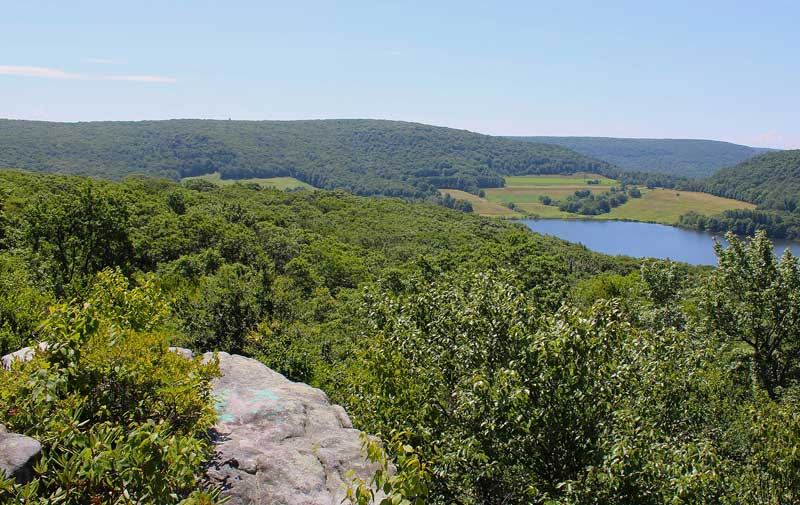Journey to the American Founding
July 13 1773
The stories we’re seeing from the last half of 1772 and early 1773 are a mixture of change and continuity. Surrounding the mixture is an intensification of actions and decisions. The new and old twist together in revolving cycles. The pace is not what it once was—it has picked up speed.


By Calzarette – Own work, CC BY-SA 4.0 – via Wikimedia Commons Negro Mountain and Deer Valley Lake from Camp Buckey Overlook in Somerset County, Pennsylvania.
Excerpts from: Americanism Redux: July 13, on the Journey to the American Founding, 250 years ago today, in 1773
He was left, left around here somewhere on this rise of land in the thick, dense forest. His comrades told him they would hide him so the Natives he’d been fighting wouldn’t come back and torture him to death. . . . He growled, heavy of breath and drenched in sweat, “I’ll die soon ‘nough and that’s good ‘nough for me.” It was sneer and statement all at once, a declaration of final independence for the fatally wounded free black man known as Nemisis. . . .
That was in 1756, when he lay wounded from a ferocious battle fought against Native tribes during the French and Indian War, in these woods, ridges, and ravines southeast of Fort Pitt (modern Pittsburgh). A gigantic man, Nemisis was the most feared soldier in his British-colonial military unit. . . .
Today, 250 years ago, Negro Mountain sits within a new home-name. It’s Turkeyfoot Township, carved out of Brothervalley Township in Bedford County, Pennsylvania. . . . a New World foreshadowing of a future British Prime Minister’s phrase of “blood, toil, tears, and sweat.” They’ve moved in from the British colonies of Maryland and Virginia . . . They fight Natives, they fight the woods and land, they may fight each other, they fight life until, like Nemisis, they meet the moment of death. . . .
While they’re coming together in the new township of Turkeyfoot in the Pennsylvania woods, another group comes together along the salt water of Boston, Massachusetts today, 250 years ago.
These names seem to pop up a lot on the same sheets of paper and today is no different—Samuel Adams and John Hancock, along with more than fifty other people who have coalesced over the cause of American colonial rights. But today’s petition to the Suffolk County justices of the peace and the Boston town selectmen . . . is about asking for help for an elderly man. They want to help George Fetcham who is too frail to continue his lifelong work as a shipwright—master naval carpenter— . . . Fetcham’s idea is to open a small shop aboard a small ship docked in Boston harbor. . . he’s planning to sell “a few necessary Articles of Life to the Neighborhood” and, remember the key word is “necessary”, he’ll sell liquor to local boatmen and dockworkers. . . . In a way, it’s an oceanside version of what Turkeyfoot wants to become.
Oceanside, or nearly so, in London, England sits sixty-seven years old Benjamin Franklin. He’s writing a 3000-word letter to William Franklin, his son by an unwed mother other than his wife Deborah, the name hidden from prying eyes, a concealment lasting far into the future . . .
The letter is, as they used to say, a tour de force. Father Benjamin guides Son William through his beliefs about the right of revolution in changing from one society to another. He also describes his views on the role that land ownership has in such a change, especially in land shifting from native to newcomer and the newcomer’s rebirthed condition of society. Franklin writes derisively of the British monarch’s decision to curtail purchases of Native land in America. He redirects his letter from here into a reflection on various politicians and political influencers . . .
Newspaper readers in London are finding out for the first time that a group of “Patriotic” legislators in Virginia have formed a “Committee of Correspondence” to “Superintend” laws from Parliament. It’s a brief report that takes barely a minute to peruse and will only mean more than a minute’s thought if the reader has a wealth of prior knowledge. What does “superintend” suggest?
The short bit of strange news, the exhausting letter, the friendly petition, and the newly birthed place with the storybook name and the mysterious mountain are all today, 250 years ago.
Also
Four men have combined to produce a 30-page history of chillingly dramatic proportions. The problem is that it’s entirely factual, or fact-based, and the history is as recent as the day before yesterday, which means that the fire is still burning and could be getting worse.
Josef Fayni, Antonio Maria Bucareli y Ursua, Domingo Xinaga, and Franciso Xavier Balenzuelas write the true story of a rebellion in Durango, Mexico of New Spain. Natives have joined with renegades of mixed ancestry to launch a war against Spanish colonizers. Calaxtrin, an Apache Native, is their leader and the tactics and strategy of his forces are stunningly effective. . . . The four-man writing team hope to hear of changes to help address the uprising. . . .
For You Now
We’re seeing two versions here, aren’t we? We have the British and the Spanish. Two very different cultures and sets of decisions and actions. Two different pathways of information-gathering. . . .
They do overlap. Enslavement exists in both, as do defined roles and status for men, women, and children. Troubling relations with Natives exist in both. Frames of governmental structure exist in both. . . .
They also diverge. Things feel much more present and readily-at-hand in New Spain. The imperial force and the imperial power go together more swiftly and with less mental separation between them, at least in comparison to that of British America. . . .
Continuity and change, similarity and difference.
Suggestion
Take a moment and consider this—do parallels in separation still have a relationship to each other? And do the British and Spanish worlds of 250 years ago today underscore your point?
TITLE: Americanism Redux: July 13, on the journey to the American Founding, 250 years ago today, in 1773
By Dr. Dan Miller
To know us better then is to know us more fully now. Welcome to Americanism Redux and my one-a-week stories of 250 years ago. For the all the stories thus far, Visit Historical Solutions, Dr Dan Miller’s website>

Reference: The Remnant Trust Collection
Numb. IV. Containing a Conversation on the Present Crisis of Publick Affairs – Written under the name of “The Occasional Writer” in 1738- Reference #1075
“Resembling much of the international and geopolitical dynamics we see today in 2023, this work, written in 1738, pertains to part of the Great-Power struggles of the eighteenth century.”
View The Remnant Trust “Wisdom of the Ages Athenaeum PDF for reference>
Journey to the American Founding
Welcome to Americanism Redux, a series by historian author, Dr. Dan Miller. He explores what Americanism meant 250 years ago and its significance for America today.
What Can I Do?
We invite you to share our passion for Individual Liberty and Human Dignity to a new generation including educators, students, business leaders and Americans from all walks of life.




